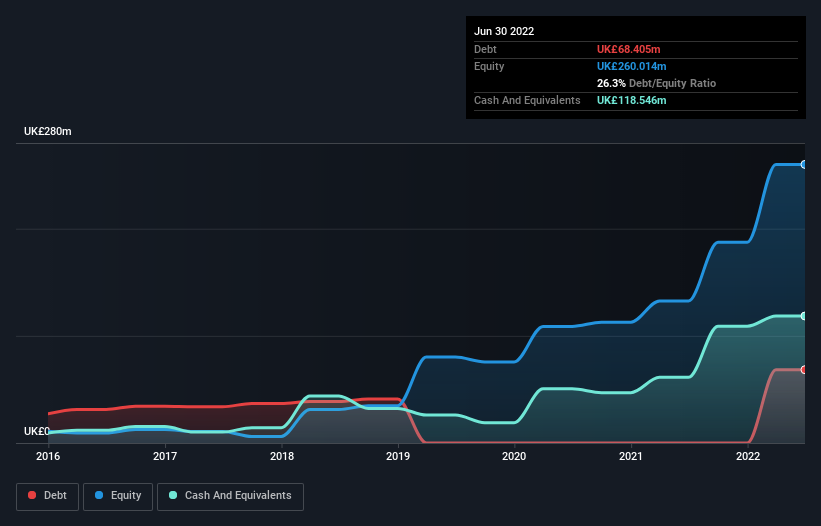
Howard Marks put it nicely when he said that, rather than worrying about share price volatility, 'The possibility of permanent loss is the risk I worry about... and every practical investor I know worries about.' When we think about how risky a company is, we always like to look at its use of debt, since debt overload can lead to ruin. We note that Oxford Biomedica plc (LON:OXB) does have debt on its balance sheet. But is this debt a concern to shareholders?
When Is Debt A Problem?
Debt is a tool to help businesses grow, but if a business is incapable of paying off its lenders, then it exists at their mercy. Part and parcel of capitalism is the process of 'creative destruction' where failed businesses are mercilessly liquidated by their bankers. While that is not too common, we often do see indebted companies permanently diluting shareholders because lenders force them to raise capital at a distressed price. Having said that, the most common situation is where a company manages its debt reasonably well - and to its own advantage. The first step when considering a company's debt levels is to consider its cash and debt together.
View our latest analysis for Oxford Biomedica
What Is Oxford Biomedica's Net Debt?
You can click the graphic below for the historical numbers, but it shows that as of June 2022 Oxford Biomedica had UK£68.4m of debt, an increase on none, over one year. However, its balance sheet shows it holds UK£118.5m in cash, so it actually has UK£50.1m net cash.

How Strong Is Oxford Biomedica's Balance Sheet?
We can see from the most recent balance sheet that Oxford Biomedica had liabilities of UK£110.8m falling due within a year, and liabilities of UK£95.9m due beyond that. Offsetting these obligations, it had cash of UK£118.5m as well as receivables valued at UK£66.6m due within 12 months. So its liabilities outweigh the sum of its cash and (near-term) receivables by UK£21.6m.
Of course, Oxford Biomedica has a market capitalization of UK£318.0m, so these liabilities are probably manageable. Having said that, it's clear that we should continue to monitor its balance sheet, lest it change for the worse. While it does have liabilities worth noting, Oxford Biomedica also has more cash than debt, so we're pretty confident it can manage its debt safely. When analysing debt levels, the balance sheet is the obvious place to start. But ultimately the future profitability of the business will decide if Oxford Biomedica can strengthen its balance sheet over time. So if you're focused on the future you can check out this free report showing analyst profit forecasts.
In the last year Oxford Biomedica had a loss before interest and tax, and actually shrunk its revenue by 7.0%, to UK£126m. We would much prefer see growth.
So How Risky Is Oxford Biomedica?
By their very nature companies that are losing money are more risky than those with a long history of profitability. And in the last year Oxford Biomedica had an earnings before interest and tax (EBIT) loss, truth be told. And over the same period it saw negative free cash outflow of UK£33m and booked a UK£25m accounting loss. With only UK£50.1m on the balance sheet, it would appear that its going to need to raise capital again soon. Overall, we'd say the stock is a bit risky, and we're usually very cautious until we see positive free cash flow. The balance sheet is clearly the area to focus on when you are analysing debt. However, not all investment risk resides within the balance sheet - far from it. To that end, you should be aware of the 2 warning signs we've spotted with Oxford Biomedica .
If, after all that, you're more interested in a fast growing company with a rock-solid balance sheet, then check out our list of net cash growth stocks without delay.
New: AI Stock Screener & Alerts
Our new AI Stock Screener scans the market every day to uncover opportunities.
• Dividend Powerhouses (3%+ Yield)
• Undervalued Small Caps with Insider Buying
• High growth Tech and AI Companies
Or build your own from over 50 metrics.
Have feedback on this article? Concerned about the content? Get in touch with us directly. Alternatively, email editorial-team (at) simplywallst.com.
This article by Simply Wall St is general in nature. We provide commentary based on historical data and analyst forecasts only using an unbiased methodology and our articles are not intended to be financial advice. It does not constitute a recommendation to buy or sell any stock, and does not take account of your objectives, or your financial situation. We aim to bring you long-term focused analysis driven by fundamental data. Note that our analysis may not factor in the latest price-sensitive company announcements or qualitative material. Simply Wall St has no position in any stocks mentioned.
About LSE:OXB
Oxford Biomedica
A contract development and manufacturing organization, focuses on delivering therapies to patients worldwide.
Good value with reasonable growth potential.
Similar Companies
Market Insights
Community Narratives




